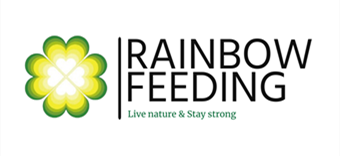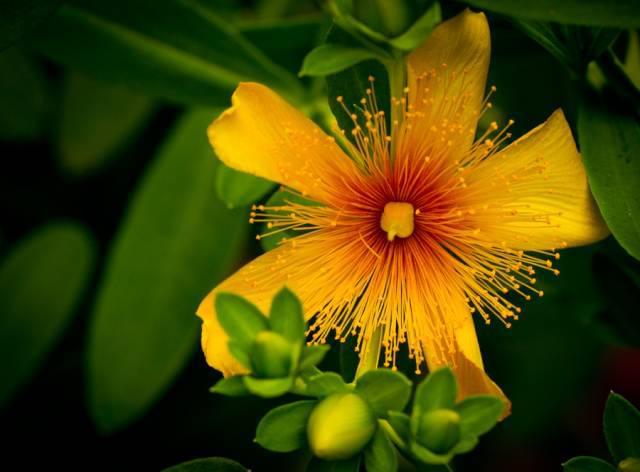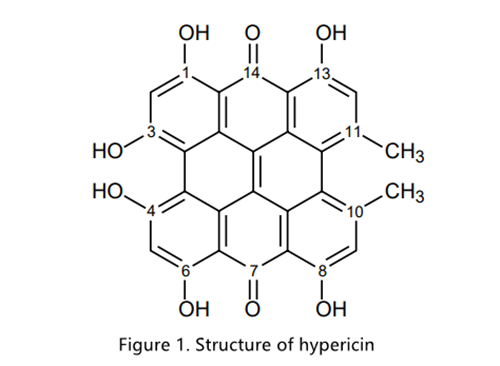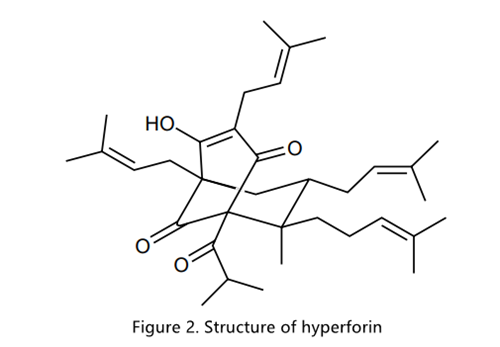St. John’s Wort Extract: Hypericin and Hyperforin
The plant St. John’s wort (Hypericum perforatum) is a wild low evergreen shrub with attractive bright yellow flowers grown in many regions of the Northern Hemisphere. St. John’s wort is known for its antidepressant properties and it has been referred to as “Prozac from the plant kingdom”. Other functions like antiviral, anti-tumor also has been studied more and more. Hypericin and hyperforin are the two chemicals with significant biological activity in St. John’s wort extract. Both are complex molecules with unusual biological properties and relevant medical applications.
Hypericin(C30H16O8)
For many years the main active ingredient in St. John’s wort has been identified as the chemical hypericin, its structure is shown in Figure 1. It is a distant analog of para-quinone and its fundamental structure is similar to that of anthraquinone, and has a much more extensive aromatic system. Pure hypericin was first isolated by Brockmann and coworkers in 1942 and then this structural assignment was substantiated by the laboratory synthesis of hypericin. Hypericin is the ingredient for the reason that St. John’s wort extract is poisonous to range animals. Ingestion followed by exposure to direct sunlight can cause inflammation of skin and mucous membranes and may lead to death.
St. John’s wort has been reported to be an effective antidepressant. For many years the active ingredient responsible for the antidepressant activity was assumed to be hypericin, hence all medications are standardized for it, normally to 0.3% hypericin. However, the significance of the role of hypericin had not been established clearly and it was also found that extracts without hypericin retain antidepressant activity.
Hypericin has photosensitivity( also called hypericism): under light conditions, hypericin absorbs photons and then excites singlet oxygen, releasing energy and destroying fine particles. The cell membrane affects the normal physiological function of proteins and nucleic acids. Its antiviral properties are thought to be related to its photosensitive activity.
Hyperforin(C35H52O4)
Early studies considered hypericin to be the main active ingredient in antidepressants. With further study of hypericin perforatum extract, the antidepressant and mood-modulating activity of St. John’s wort might be due to another complex compound hyperforin was suggested in 1998. Since then hyperforin has been investigated extensively. The structure of hyperforin is and its structure is shown in Figure 2. It bears no relation to that of hypericin: it is bicyclic, oxygenated, and unsaturated, but not aromatic and it is classified as a derivative of phloroglucinol. In the dried herb St. John’s wort, hyperforin occurs in a relatively high concentration of 2–4%; however, it is quite sensitive to air oxidation and content in the herbal drug may vary.
This potent compound is known for its impressive ability to inhibit the reuptake of important neurotransmitters, including serotonin, norepinephrine, dopamine, and GABA. By regulating the reuptake of these neurotransmitters, hyperforin can affect mood regulation and emotional health. Clinical studies have shown that the antidepressant effect of hypericin preparations is significantly better than placebo, and its efficacy is comparable to that of standard antidepressants maprotiline, imipramine, and amitriptyline, but with fewer adverse reactions and treatment costs.



